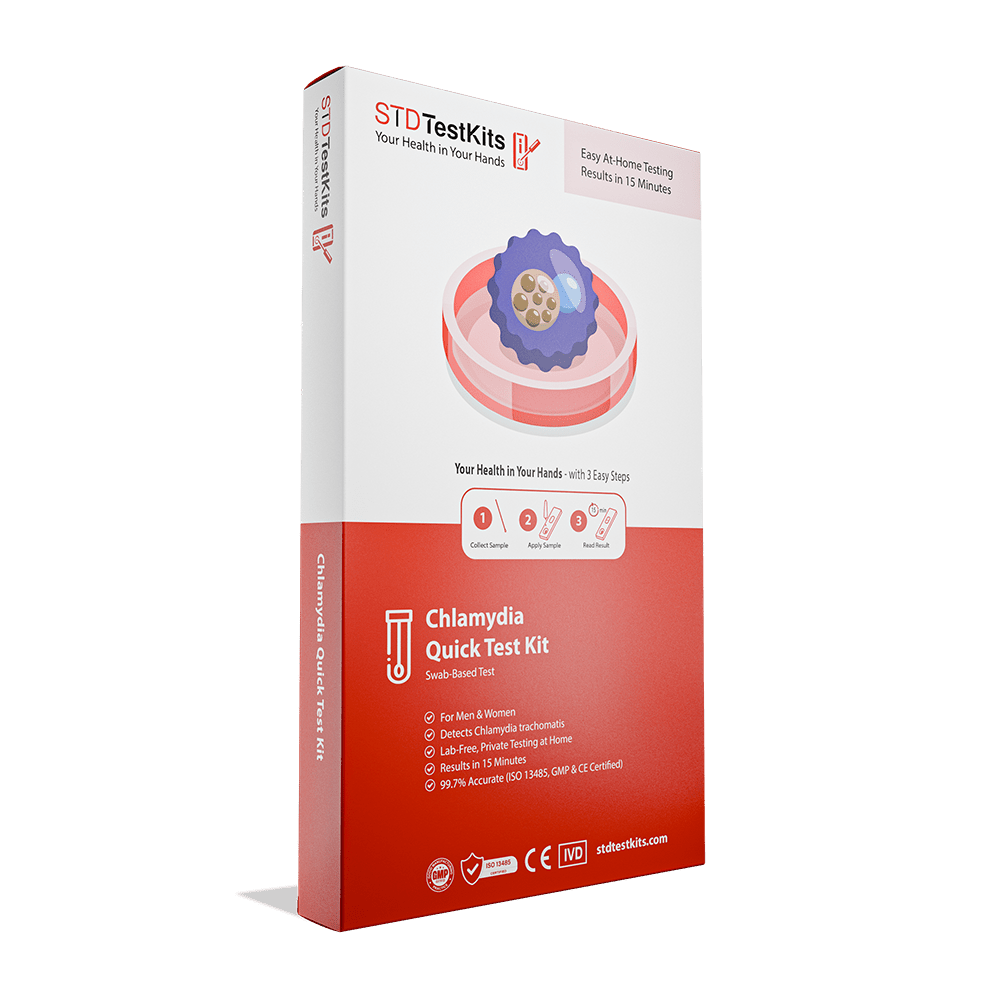How Accurate Are Chlamydia At Home Tests?
Quick Answer: If your at-home STD test comes back positive, the next steps are simple: confirm with a follow-up test (lab or mail-in), start treatment as soon as possible, and let recent partners know so they can protect themselves too. Most STDs are highly treatable when caught early.
Why This Moment Matters
Robert, 29, ordered an at-home chlamydia and gonorrhea kit after weeks of spotting between periods. When the cassette showed two pink lines, he froze. He almost threw the test away, hoping it was a mistake. Instead, he opened her laptop and looked up what to do next. Within 48 hours, hhe had a confirmatory lab result and a prescription in hand. Three months later, he retested, negative.
“At first it felt like the ground was falling out from under me. But the steps were clear once I knew them. The test didn’t ruin me, it saved me.”
Robert’s story isn’t unusual. The shock is real, but so is the relief when you realize there’s a path forward.
Getting a positive result at home can feel isolating, you’re in your bathroom, phone in one hand, test cassette in the other, and no nurse on standby to guide you. But you’re not alone. Millions of people every year face the same moment of uncertainty, and most go on to handle it just fine.
This is the turning point where fear can spiral, or you can redirect it into action. A positive STD test at home is not a life sentence. It’s a signal that your body needs care. And the faster you move from “what if” to “what next,” the less likely you are to deal with long-term consequences like chronic pain or fertility issues.

People are also reading: What Does HPV Look Like in Men? (Sometimes, Nothing at All)
Step One: Confirm the Result
At-home STD kits are accurate, but no test is perfect. A faint line can mean an early infection, or just user error. That’s why medical guidelines recommend confirmatory testing whenever an at-home test reads positive. You’ve got options:
You can book a same-day appointment at a local clinic for a lab-based NAAT test (the gold standard).
You can mail in a follow-up kit if leaving the house feels overwhelming.
Some telehealth providers will send you a lab slip or prescribe antibiotics after reviewing your test result photo.
Whichever route you choose, don’t wait. Confirmation is about clarity, not delay. The sooner you know for sure, the sooner you can treat and move on.
Start Treatment, Don’t Wait It Out
Once your result is confirmed, treatment should be your immediate priority. The good news? Most common STDs detected by at-home kits, like chlamydia, gonorrhea, and syphilis, are curable with antibiotics. Others, like herpes or HIV, are manageable with ongoing medication that keeps you healthy and prevents transmission.
You don’t need to sit in a waiting room for hours to get treated. Many telehealth services now prescribe antibiotics after a virtual visit, and some pharmacies can fill the prescription the same day. If you prefer in-person care, urgent care centers and sexual health clinics are familiar with these infections and can get you started quickly.
What not to do: don’t assume the infection will clear on its own, and don’t try to use leftover antibiotics from a past illness. STDs require specific medications, in precise doses, for a set length of time. Cutting corners risks making the infection worse, or resistant.
Table 1. Common STDs detected by at-home kits, the typical treatments, and what “safe again” realistically looks like.
Talk to Your Partner (or Partners)
This is the step most people dread, but it’s one of the most important. If you test positive, there’s a chance your partner has the infection too, even if they don’t feel a thing. Telling them is not about blame; it’s about care.
Here’s one simple script: “I tested positive for [STD]. You should get tested too, just to be safe.”
That’s it. No apologies, no courtroom cross-examination. Just facts. You’re giving them the chance to protect their health. If the idea of saying it out loud makes your chest tighten, know this: there are anonymous partner notification services that can send the message for you. You don’t have to carry the whole weight alone.
And remember, needing to have this conversation doesn’t mean you’re dirty or reckless. It means you’re responsible enough to face the truth and help others do the same.
Derrick, 25, took a rapid test at home after his girlfriend urged him to. It came back positive for gonorrhea. He spent two days avoiding her calls, terrified she’d think he cheated. Finally, he met her at a park bench and blurted it out. Instead of anger, she thanked him for being honest. They both went to the clinic together and started treatment the same afternoon.
“It wasn’t easy, but it was easier than pretending nothing was wrong.”
Conversations like Derrick’s are rarely as bad as the fear leading up to them. In fact, honesty often strengthens relationships rather than destroying them.
Pause on Sex, For Now
This part is straightforward. If you test positive, hit pause on sexual activity until treatment is complete and, in some cases, until a follow-up test confirms you’re clear. For chlamydia and gonorrhea, that usually means finishing a 7-day antibiotic course and waiting at least a week after your last dose before having sex again.
It’s tempting to push through or assume condoms will cover it, but even with protection, bacteria can linger in places condoms don’t cover. A short break now prevents reinfection later, for both you and your partner.
If the thought of “pressing pause” feels impossible, try reframing it: this isn’t about restriction, it’s about recovery. You’re giving your body the space to heal, so sex can feel safe and enjoyable again without worry hanging over your head.
Table 2. How long to “pause” sex after a positive STD test, by infection and treatment type.
Retest and Stay in the Clear
Even after treatment, you’re not finished. Retesting is a crucial step that too many people skip. The CDC recommends that anyone who tests positive for chlamydia or gonorrhea retest about three months after treatment, even if you feel fine. Why? Because reinfection is common, and catching it early prevents long-term complications like pelvic inflammatory disease or infertility.
If you’re pregnant, immunocompromised, or under 25, retesting isn’t just suggested, it’s strongly advised. Think of it like checking your locks twice before bed: peace of mind that you’re really safe.
Understand False Positives and Negatives
Seeing a positive line can feel like the end of the world, but here’s the truth: at-home STD kits are very accurate, but no test is flawless. A faint positive may be a true early infection, or it could be a user error (too much sample, not enough, wrong timing). That’s why confirmation is always part of the plan.
False negatives can happen too, especially if you tested too soon after exposure. For most bacterial STDs like chlamydia and gonorrhea, tests become reliable around 7 to 14 days after exposure. Test before that, and you might get a false sense of security. If you had a risk encounter and tested early, schedule a follow-up. Your future self will thank you.

People are also reading: STD Testing Regret: 10 Things I Wish I Knew the First Time
Protect Your Privacy
Privacy is one of the main reasons people choose to test at home. And that doesn't change even if the result is positive. This is what you can expect:
Most companies that send you at-home tests send the results and instructions for what to do next in unmarked boxes or secure portals. You have to share your results for anyone to see them. You can do telehealth visits on your phone, and prescriptions can often be sent directly to your local pharmacy in your name without any fuss.
This privacy is a lifeline for a lot of people. It lets you act without worrying about being judged, shamed, or exposed. That means you're more likely to get the care you need.
Healing Beyond the Test Result
Testing positive can feel like a gut punch, even when the infection is treatable. But here’s the truth: you’re not broken, you’re not alone, and this doesn’t define you. Plenty of people have been exactly where you are, sitting on the edge of a bed, holding a test, wondering what it means for their future. The answer? It means you care enough to know. That’s powerful.
STDs don’t erase your worth, your desirability, or your right to safe, satisfying intimacy. What they do is remind us that bodies are human, sometimes messy, sometimes vulnerable, always deserving of care. If you’re struggling emotionally, consider talking with a trusted friend or therapist. Stigma grows in silence; it shrinks when you bring it into the open.
FAQs
1. Is my positive result definitely real?
Most of the time, yes. But here’s the catch: no test is perfect. If you’ve got a clear positive line, chances are good it’s real, but confirm it. Think of it like double-checking a pregnancy test: better to know for sure than to second-guess for weeks.
2. Do I need to tell my partner right away?
Quick answer: yes. Waiting doesn’t make the infection disappear. A simple “Hey, I tested positive for [STD], you should get tested too” works. It doesn’t have to be dramatic. And if you can’t bring yourself to say it out loud, anonymous text services exist. Use the tools. Protect both of you.
3. What if I already had sex after the positive test?
Okay, deep breath. You’re not doomed, and you’re not the only one who’s slipped. Just stop for now, get treated, and let your partner(s) know so they can test too. What matters isn’t that it happened, it’s what you do next to break the chain.
4. Do I have to take antibiotics forever?
Nope. Most bacterial STDs like chlamydia or gonorrhea are one-and-done with antibiotics. One week of pills or even a single dose, and you’re cleared. Chronic infections like HIV or herpes are different, they’re managed, not cured, but modern meds make them livable, not life-ending.
5. Can I drink while I’m on the meds?
Technically, it depends on the drug. Some antibiotics (like metronidazole) mix terribly with alcohol, you’ll regret it fast. Others aren’t as strict. Bottom line: check the instructions that come with your prescription. A few nights off alcohol is a small trade for a clean bill of health.
6. How long do I have to wait before I can have sex again?
Usually about a week after you finish treatment for curable STDs. That “seven-day wait” is the standard. It feels long when you’re in the middle of it, but it’s shorter than dealing with a reinfection because you jumped back in too soon. Worth it.
7. Am I going to lose my chance at having kids?
Not if you treat it. Fertility problems come from untreated infections that climb higher into the reproductive system. By testing, treating, and retesting, you’re actually protecting your future options, not ruining them.
8. Can I get treatment without showing up at a clinic?
Yes. Telehealth has changed the game. Many services let you upload a photo of your test or answer a quick survey, then send the prescription to your local pharmacy. It’s private, fast, and keeps you from sitting under fluorescent lights in a waiting room.
9. Does a positive test mean my partner cheated?
Not necessarily. Some STDs hang out silently for months, even years, before anyone notices. So a new positive doesn’t automatically mean betrayal. The only way forward is a conversation, not assumptions.
10. How do I make sure this doesn’t happen again?
Think of STD prevention as tune-ups, not punishments. Regular testing, condoms, and making “we test before we stop using protection” a normal relationship conversation will save you from a repeat performance. It’s not about fear, it’s about maintenance, like oil changes for your sex life.
Taking Back Control: Your Next Move
If you’ve made it this far, you already know the hardest part isn’t the test result itself, it’s the head noise that comes with it. The “what ifs,” the “does this make me dirty,” the “will anyone ever want me again.” Let’s cut through that: an STD is an infection, not a life sentence. It doesn’t erase your worth, and it doesn’t cancel your right to intimacy, love, or pleasure. What it does is give you a moment of choice. You either ignore it and hope for the best, or you face it head-on and come out stronger. You already know which one got you here.
The path forward is clear: confirm the result, get treated, give your body the space to heal, and retest to protect your future. That’s not punishment, that’s self-respect. And it’s not about living in fear. It’s about living without the constant hum of doubt in the back of your mind. Imagine waking up and not replaying that test strip in your head. Imagine knowing, not wondering.
You don’t have to do this alone. Confidential testing is available right now, shipped discreetly, ready when you are. No side-eyes from receptionists, no awkward waiting rooms, no shame. Just clarity. Just relief. Just the knowledge that you took control of your own health before anyone else had the chance to.
Explore at-home STD test kits here and take the next step on your own terms.This isn't about fear; it's about power. Your body needs answers, and your future needs to be safe. Don't let shame or silence keep you from moving forward. Get the clarity you need today, and then go back to your life knowing that you dealt with it, moved on, and are now stronger than before.
How We Sourced This: We built this guide from about 15 reputable references including CDC guidelines, peer-reviewed journals, and sexual health organizations.
Sources
1. Next Steps After Testing Positive for Gonorrhea or Chlamydia | CDC
2. STD Testing: What’s Right for You | Mayo Clinic
3. Testing for STIs at Home | ASHA Sexual Health
4. Home STD Tests Are Convenient, But There Are Drawbacks | UAB Medicine
5. STI Treatment Guidelines, 2021 | CDC (PDF)
About the Author
Dr. F. David, MD is a board-certified infectious disease specialist focused on STI prevention, diagnosis, and treatment.
Reviewed by: Dr. L. Hernandez, MPH | Last medically reviewed: September 2025







